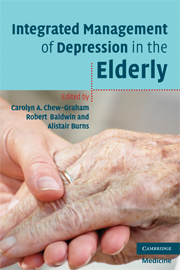Book contents
- Frontmatter
- Contents
- Contributors
- Foreword
- Preface
- Acknowledgements
- 1 Late-life depression: an introduction
- 2 Management of late-life depression
- 3 Management of late-life depression in primary care: case studies UK
- 4 Management of more complicated depression in primary care: case studies UK
- 5 Management of late-life depression across primary and secondary care: case studies UK
- 6 Management of late-life depression around the world: summary of international commentaries
- 7 Resources
- Appendix: International commentaries
- Index
- References
7 - Resources
Published online by Cambridge University Press: 18 December 2009
- Frontmatter
- Contents
- Contributors
- Foreword
- Preface
- Acknowledgements
- 1 Late-life depression: an introduction
- 2 Management of late-life depression
- 3 Management of late-life depression in primary care: case studies UK
- 4 Management of more complicated depression in primary care: case studies UK
- 5 Management of late-life depression across primary and secondary care: case studies UK
- 6 Management of late-life depression around the world: summary of international commentaries
- 7 Resources
- Appendix: International commentaries
- Index
- References
Summary
The aim of this chapter is bring together the variety of information found in the preceding chapters and commentaries into a practical resource for practitioners.
Screening for depression in older people
The usefulness of screening for depression depends on the baseline prevalence in the population screened; the higher the baseline prevalence the more likely is the screening to be cost-effective. Thus, targeted screening is more effective than screening an entire population. Examples include screening residents of a nursing home or the list of older patients on a general practice with physical conditions known to have strong links with depression, such as diabetes, chronic obstructive pulmonary disease or chronic heart disease (Krishnan et al. 2002). Iliffe and colleagues (page 95) add that screening should be linked to patients' perceptions of what is important and their SPICE acronym suggests five priority areas: senses, physical activity, incontinence, cognition and emotional distress.
The Geriatric Depression Scale (GDS) has been advocated as a screening instrument. It comprises 30 questions and takes about 10 minutes to complete (Table 7.1). The GDS avoids questions which rely on physical symptoms, and uses a simple yes/no format. Although designed to be self-administered, rater-assistance is acceptable. There are shorter versions, including a four-item (questions 1, 3, 8 and 9) and a 15-item version (Table 7.1) which may be more appropriate for use in primary care.
- Type
- Chapter
- Information
- Integrated Management of Depression in the Elderly , pp. 114 - 139Publisher: Cambridge University PressPrint publication year: 2008



